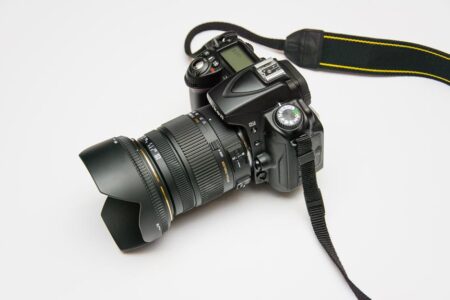Investigators are usually armed with cameras and camcorders that have many features that are beneficial when conducting covert surveillance and recording interviews.
It lets us see what’s going on at a given time or place, which provides indisputable evidence for our clients.
You could ask for some help from a private detective.
The tools are out there, all you have to do is find them and start using them.
You’re going to learn how to hide a camera in a ceiling fan.
It takes little skill but takes some time to complete correctly.
Here’s how to hide a camera in a ceiling fan. The step-by-step directions are detailed and easy to follow.
How to Hide a Camera in a Ceiling Fan: 10 Easy Steps
Step One: Turn off the electricity
It’s best not to proceed with this project if you can’t turn off the electricity. If you decide to continue, at your own risk, make sure you ask your electrician how the circuits are accessed.
Step Two: Insert the drill into the ceiling
Start by drilling a small hole in the ceiling with a small drill bit. Make small circles around the area where you’re going to make a full circle with your drill bit. You’re trying to make a hole big enough for the ladder to slide in. Make sure you use a flashlight to see if the ceiling is hollow or solid once you’re done.
Step Three: Cut and measure
Take the flashlight test to figure out if the area is hollow, then take your next step by measuring how big your opening needs to be. You can use a tape measure for that. Mark the measurements on the ceiling with an old credit card or something similar, then cut them out.
Depending on the size of the hole saw bit you use, your local hardware store can help you. Once you cut the hole, you’ll be left with a small circle of material.
Step Four: Remove the material from the fan and prepare it
The ceiling fan should be removed, and your new ceiling opening should be outside. Rinse it out as much as you can with water or an air compressor. You should take all the pieces of the fan out, and you should take the new opening outside. Use water or an air compressor to rinse it out.
If you dry it with a cloth or anything else, you’ll just make more particles go into the air, which will make you cough.
Make sure your work area is clean and use your shop vac when needed. Once you’re done and happy with your results, take the fan outside and clean it off.
Step Five: Prepare the camera and fan by attaching them
Make sure the ceiling fan is upside down. Once your camera is on the mount, you can start putting the wire through the ceiling hole. Before screwing into the ceiling, place two small screws on each side of your drill bit. This won’t make your new hole in the ceiling spin and break.
After removing all screws, place the fan back over your camera and replace the screws with the ones included with most cameras of this size. You don’t want this fan to fall over at the slightest touch, so drill into a stud or secure it firmly before placing it.
Step Six: Hide and plug the wires
You can plug in your camera once it’s secure. Use a staple gun or tack to secure the wire back in place once you’re happy with how much wire is showing. Before you replace all screws in place, you can also drill small holes along the ceiling fan’s edge and run the wire through them.
The extra wire should be hidden behind furniture or in an electrical box. It is best to make sure these wires are not visible to anyone using the ceiling fan; if you have an uncovered electrical box in your room, use it to conceal the wires as best you can.
Step Six: Have fun testing
As soon as all the items have been hidden to your satisfaction, the fan can be turned on and plugged back in. You should test everything before putting it all away. You do not want to complete this project only to discover that something does not work, and you have to begin over.
Put screws in the right places, and you’re done. Attach the camera mount firmly before placing the fan back in place with a strong adhesive. If you’re using a remote control, you can test the camera functions before you put away all your tools. This will help you hide a camera in your ceiling fan.
Tricks of a ceiling camera
In Drywall Ceilings, How Do You Hide a Camera?
Ceiling drywall is pretty easy to hang a camera on, but it takes some finesse because it’s so thick. The top part that hangs down from the ceiling doesn’t have a name, but I call it the halo. Cameras are usually mounted on walls or doors, so the halo doesn’t have any mounting holes.
You can fix this problem by making your halo out of plywood or medium-density fiberboard and attaching it to the mount under the camera or below it if it’s upside down or rotates. Anchors may be required for the ceiling drywall. Check the weight load of the anchor you choose before using it, whether it’s normal drywall anchors or toggle bolts.
Conclusion
Using some basic tools and a little know-how, you can make an undetectable surveillance system for your house. All you need is a ceiling fan with no light kit, two tiny screws to attach the camera mount to the blades, a screwdriver, four long bolts large enough for your threads on either side of the blade mounting plate, two extras just in case, and your camera module.
When you’ve assembled all of these pieces, tighten them down with screws or bolts, so they won’t loosen over time due to vibrations from movement or air currents in your house. This article has provided an excellent guide for hiding a camera in a ceiling fan.
Frequently asked questions
How do you find a hidden camera in the ceiling?
Let’s begin with the simplest.
- Each time you enter a new room, scan your surroundings thoroughly for odd objects.
- Make use of a flashlight.
- Make use of your smartphone’s camera.
- Wi-Fi network scanning.
- A phone call can be used to detect interference.
- Make use of an app that detects hidden cameras.
- Specialized RF detectors should be used.
Can a camera be hidden in a vent?
There are hidden cameras hidden in vents, lamps, power outlets, and even unassuming objects like humidifiers and TV remote controls. You must see these cameras to be convinced they exist. Tap or click to see 10 hidden cameras you would never suspect were there.
Can a cell phone detect a hidden camera?
Cell phones are capable of detecting hidden cameras. Download a hidden camera detector app. Once the app is installed, open it and scan the area for hidden cameras. The app will then send you an alert.
Do hidden cameras need Wi-Fi?
In some cases, home security cameras aren’t connected to the internet at all. For instance, Arlo Go and Reolink Go can use LTE plans instead of Wi-Fi.








